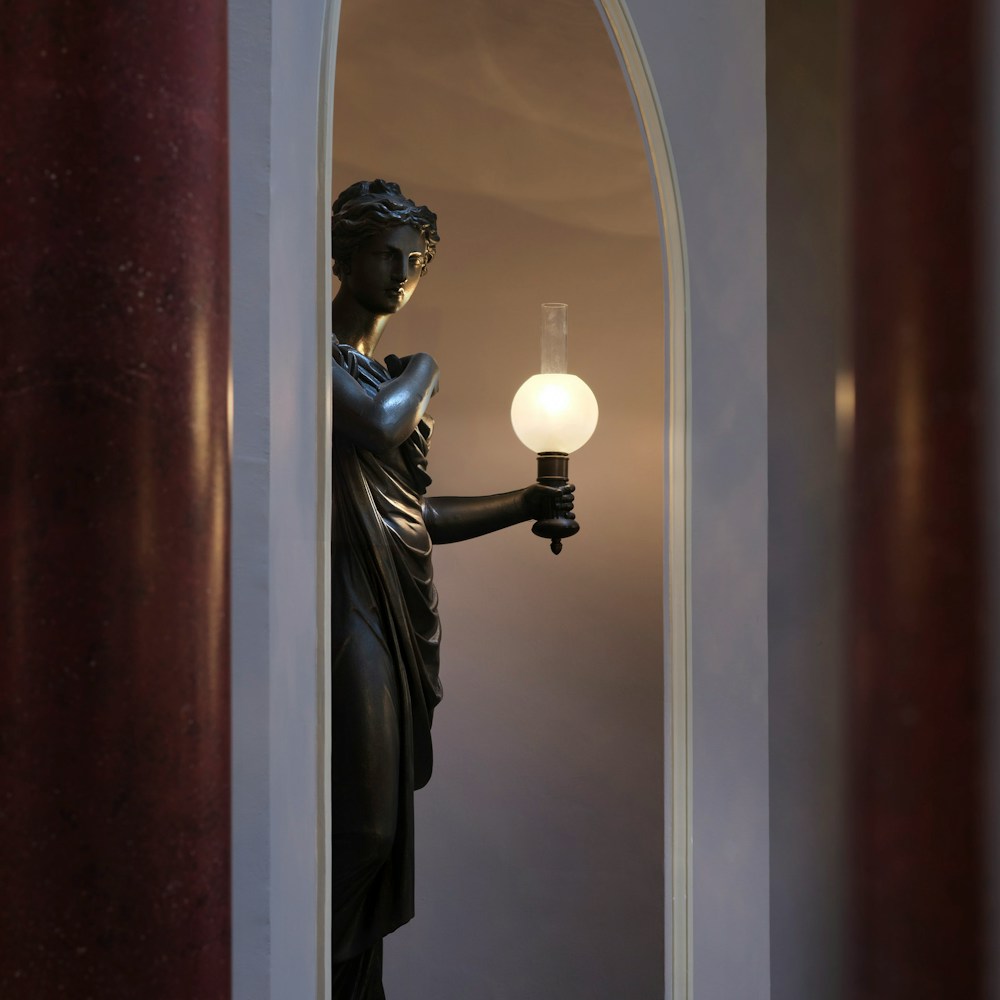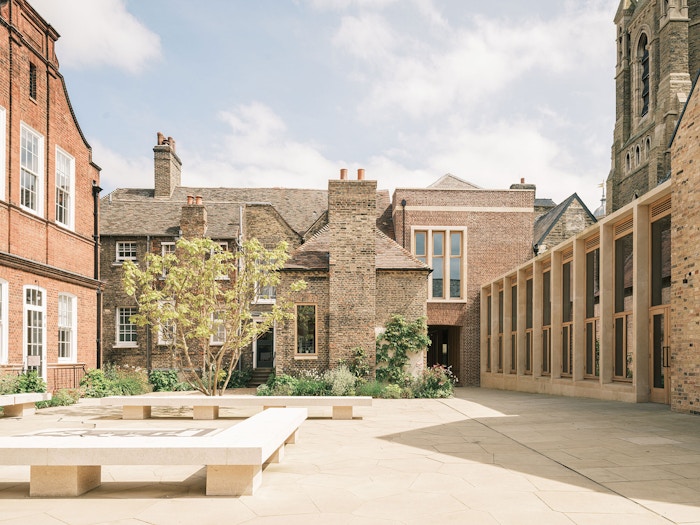
Theatre Royal Drury Lane has won Gold at the 2022 World Interiors News Awards for the Lighting Design. A collaboration between Haworth Tompkins and BDP Lighting Design, our approach was to create contemporary lighting effects that drew inspiration from the original ambience of the Georgian interior. BDP merged technical lighting methods of the 19th and 21st centuries; dimming technologies used previously only on stage and in the auditoria have been adopted throughout the whole building to maximise flexibility and balance the same level of sensitivity and atmosphere across all areas. Each individual space looks to the original design of 1810; drawings, financial records and publications from the theatre’s long history were studied to determine the focus of the lighting; whether low level standard, wall sconce or chandelier. Using this as our starting point, the team employed a series of hidden fixtures alongside visible historic pattern light fittings to reduce contrast, wash ceilings, spotlight artworks or integrated details to fixed furniture, steps or handrails. This collection of hidden details suggests the light emanates from the historic light fixtures
We recently celebrated the completion of high-quality residential homes within our Wood Street Families and Homes Hub project for the London Borough of Waltham Forest. This mixed-use scheme provides 67 new, affordable homes (29 for social rent and 38 for shared ownership) a café and a community hub which when complete will provide much needed space for local residents to access family and housing services.
In response to Waltham Forest Council’s declaration of a climate emergency, the project endeavours to exceed conventional sustainability standards and demonstrates our approach to designing high-quality homes regardless of tenure. This benchmark project for Waltham Forest sets a high standard for the design of future affordable housing. A big thank you to Waltham Forest, Hill Group and the wider design team for their contributions to this exemplar project and ensuring a collaborative spirit throughout. Read more about the project here.
The redevelopment on Atlip Road for client Atlip House Ltd has received unanimous approval by LB Brent. This residential led mixed-use development will transform an underused commercial site and provide much needed new homes, community facilities and new green public realm. Overall, the scheme comprises of:
- 885 high-quality new homes – including co-living, affordable and private housing
- A new community centre
- Creative commercial and co-working space
- Communal courtyards and play space
- Significant new public realm
This is the largest residential project to date to be approved for Haworth Tompkins. It showcases our ability to provide high-quality homes at high density using innovative construction methods and materials.
Our project for Pembroke College, Cambridge has won several awards at the CFCFI Awards. These awards recognise the very best of the buildings that are shaping Cambridge - whether through trailblazing sustainability, exemplary restoration, or community impact.
- Winner: Best Refurbishment over £3m
- Winner: Craftsmanship Award
- High Commendation: David Mackay Award for Engineering & Sustainability
- High Commendation: Contractor (Cocksedge Building Contractors)
We are honoured that the judges have recognised Pembroke Mill Lane for its innovation, design excellence, craftmanship and complexity in both design and delivery on what is a highly complex site in the historic city centre of Cambridge. We want to extend our congratulations and thanks to the whole design team – these awards recognise the importance of collaboration between all members of the client and design team – architects, contractors, structural and civil engineers, services engineers and landscape designers – in delivering ambitious and pioneering sustainable design.
The judges commented that “The project needed to apply a vast range of craft skills due to its size, complexity and multi-faceted nature. The Mill Road complex presented huge challenges, and we were awed and impressed by the quality, detailing, diversity and beauty of what has been created. We particularly commend the recycling of materials, including timber and brick; the careful sourcing of new timber; the fact that where possible historic features have been left to add character and personality; and the clever integration of new features, such as the forged grille at the street entrance.”
Theatre Royal Bath – Venue 4 has received planning and listed building consent. Venue 4 is a new community theatre located on St John’s Place and will serve as the home for the Theatre’s Engage adult participation programme and provide a dynamic space for local residents to create, rehearse and perform new shows.
Planned as a 40-seat, intimate, fringe-style venue, complete with its own foyer, it will be geared towards local grass-roots performers as well as the Theatre Royal Bath’s Engage programme, supporting local festivals and broader community initiatives, creating an exciting new piece of Bath’s cultural offer.
HT Director Lucy Picardo is joining the NLA Expert Panel on Culture 2025 to investigate how the rich and unique culture and character of the capital can be maintained, celebrated and enhanced. Lucy has considerable experience in the performing arts and cultural sectors including the refurbishment of the Grade I listed Theatre Royal Drury Lane and the restoration and renewal of the Grade II* Chichester Festival Theatre.
She is currently leading on the redevelopment of Theatr Clwyd, the extension of the Old Vic Theatre in Waterloo, the redevelopment of Grade I listed St George’s Guildhall, King’s Lynn, the Hexagon Theatre Studio in Reading, a masterplan for the London Museum Docklands and the redevelopment of Grade I listed De La Warr Pavilion.
Collated with thought leaders from across the industry, each of the 15 NLA expert panels will address the critical challenges facing London and champion bold ideas and initiatives to future-proof our industry and help drive London towards equity, sustainability and prosperity. Read more here - https://nla.london/topics/culture
2024 was a busy year at HT and as we settle into 2025, we have been reflecting on all that was achieved through the collective efforts of our team, clients and collaborators. We celebrated the completion and launch of The Warburg Institute, Lambeth Archives in Brixton, 67 affordable new homes for local people at Wood Street in Waltham Forest and the first phase of Pembroke Mill Lane in Cambridge.
Our projects won another batch of awards including a RIBA London Award for Fish Island Village, a high commendation for Pembroke Mill Lane Phase 1 at the Wood awards, Industria won a NLA Workplace award and Commercial project of the year at The London Construction Awards and National Theatre – NT Future won the Religion & Culture category at the 2024 Architecture Today, buildings that stand the test of time awards. We were also named as one of 6 inaugural AJ100 Champions for our continued commitment to sustainability and ‘all-round excellence’.
We continue to win new commissions across all our major sectors in the UK and across Europe including theatres in Stockholm and Vienna, masterplan visions at York Central, St Botolph’s quarter in Colchester and the London Museum Docklands, new buildings at Swindon Science + Innovation park and new neighbourhoods - Holloway Park in Islington and Dagenham Green Phase 2 for Peabody, we also won the Hackney New Homes Programme Design Competition which will deliver much needed council housing.
Planning permission was received for several projects - St George’s Guildhall, King’s Lynn, Bromley-by-Bow Industrial Park, Birmingham Smithfield and Hexagon studio theatre in Reading. Several projects continue to make progress on site - A.R.T in Harvard, Wembley North East Lands, the Court Theatre in New Zealand, ECU City Campus in Perth Australia, Theatr Clwyd, our first Passivhaus project Greenhill Centre in Newham, Pier Road in Bexley, The Old Vic Annex, TEG Olympia, Canning Town Old Library & Sentralbadet in Bergen.
High points for the studio include launching our first Level 6 & Level 7 apprenticeship scheme and welcoming our first two apprentices to HT. We continued to strengthen our commitment to embedding regenerative design principles across the practice with the appointment of a new sustainability designer and continued our support of the Architects Declare movement and became an inaugural sponsor of ACAN.
As a studio we celebrated a series of significant promotions from both our architectural and studio support teams rewarding the valuable contribution they have made and recognising their leading roles within the studio, work on key projects, business development and practice wide initiatives. Other highlights include Director Lucy Picardo being appointed to join the NLA Expert Panel on Culture and Associate Director Ken Okonkwo being selected as Town Architect for the London Borough of Barking and Dagenham by the Mayor of London.
The theatre construction, in a strategic alliance with the City of Vienna and Wien Holding, is intended to be completed by 2027 and will provide new cultural and economic impetus in the performing arts scene within Austria.
With 1,800 seats, this is the largest privately financed theatre project of the past 100 years and will not only be one of the most important venues in Austria, but will also set new standards in international theatre architecture.
It uniquely combines private-sector experience and cultural commitment with the highest sustainability standards, creating a contemporary entertainment hotspot in Vienna's tradition-steeped Prater district. Read more here - Link
Visualisation: Haworth Tompkins + Dietrich Untertrifaller
Construction of Perth’s first fully comprehensive, inner-city university has reached a major milestone, with the Edith Cowan University (ECU) City campus reaching its full structural height. The ‘topping out’ milestone marks major progress on one of Perth’s most significant developments, with internal fit-out and finishing works continuing throughout 2025 ahead of the campus opening in 2026.
ECU City will feature state-of-the-art learning, engagement and performance spaces giving students and staff access to learn, teach, create and perform in world-class spaces. The new home for WAAPA includes a Playhouse Theatre, Recital Hall, Flex Theatre, Jazz and Contemporary Venue, Aboriginal Performance venue, and Dance Theatre, along with a range of teaching spaces and rehearsal venues, workshop areas and dressing rooms. Haworth Tompkins is working with Australian architects Lyons, Perth-based Silver Thomas Hanley, theatre consultants CharcoalBlue, acoustics designers Marshall Day, Head contractor Multiplex and engineers Stantec.
ECU City is located on the traditional lands of the Whadjuk Noongar people.







